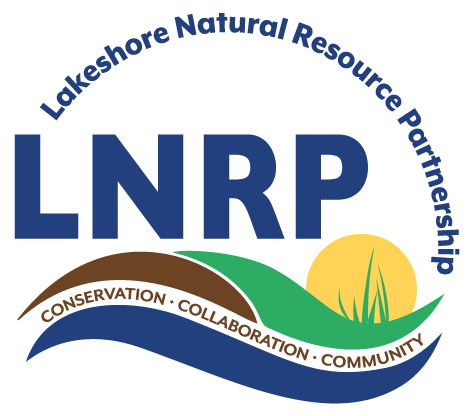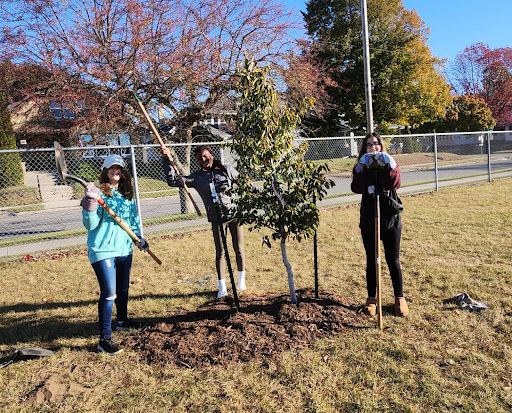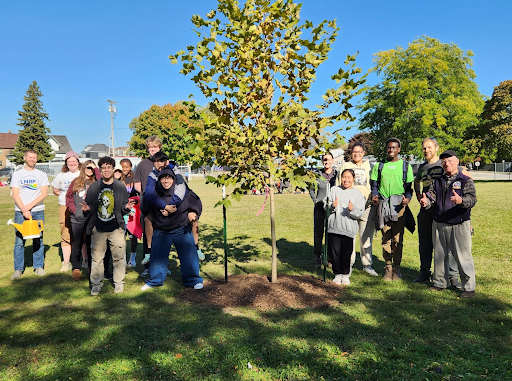Reforesting Sheboygan Schools: A Community Effort to Restore Tree Canopy
Pictured: SASD students pose with a tree they planted.
In 2023, Lakeshore Natural Resource Partnership (LNRP) and Restoration of Our Trees Sheboygan (ROOTS) launched a collaborative effort to restore the tree canopy across Sheboygan Area School District (SASD) campuses. With funding support from the Wisconsin Department of Natural Resources (WDNR) Urban Forestry Program, this initiative aims to replace over 300 ash trees lost to the Emerald Ash Borer (EAB) infestation and create vibrant, green spaces for students and the community.
Rooted in Community Engagement
This project emerged from ongoing conversations between LNRP, ROOTS, and the City of Sheboygan, recognizing the need to reforest school properties while incorporating environmental education. The idea was simple yet powerful: schools are central community spaces, and trees provide not only beauty but also critical environmental and educational benefits. ROOTS, with its established success in addressing EAB impacts in Sheboygan County, was a natural fit for leading tree-planting efforts alongside SASD teachers, students, and volunteers.
A Collaborative Effort
Key project partners include:
WDNR – Project funder through the Urban Forestry Grant Program
LNRP – Grant administrator and overall project coordinator
ROOTS – On-the-ground leadership for tree-planting events and LNRP Partner Group
SASD – Teachers like David Miller are championing urban forestry education, and students are actively participating in tree inventory and planting efforts
LEAF (K-12 Forestry Education Program) – Providing expertise in outdoor classroom development and forestry education lessons and curriculum
Project Goals and Vision
This initiative seeks to:
Reforest SASD campuses by increasing canopy coverage and biodiversity
Engage students in environmental stewardship through hands-on learning
Develop outdoor classrooms with urban forestry education components
Foster long-term community involvement in tree maintenance and conservation
By involving students in every stage—from inventorying trees to planting and maintaining them—this project provides direct exposure to the impact of invasive species and the importance of proactive conservation that fosters biodiversity. The long-term vision is to integrate urban forestry education across SASD, ensuring that future generations recognize and participate in sustainable land management practices.
Project Components
Tree Inventory – Volunteers and students are cataloging existing trees and assessing replanting needs across SASD campuses
Tree Planting – Guided by inventory results, new trees will be planted strategically to maximize benefits and resilience against future ecological threats
Outdoor Learning Spaces – New classroom areas will incorporate educational signage and hands-on environmental lessons
Current Status and Next Steps
Pictured: SASD students and teacher David Miller, LNRP Staff, and ROOTS members pose with a planted tree.
As of early 2025, the tree inventory is nearly complete, with South High School as the final assessment site. The first round of plantings took place in Fall 2024 at Cooper and Grant Elementary Schools, where 43 trees—including honey locust, serviceberry, dawn redwood, and bald cypress—were planted by students and volunteers. Plans are underway for additional plantings at Pigeon River and North High School in Spring 2025. As of January, participating teachers have been brainstorming how to incorporate urban forestry education into their lessons and school buildings.
Future efforts aim to expand plantings to additional campuses and engage broader community participation, all contingent on funding availability.
A Model for Community-Engaged Stewardship
“This project helps SASD replace their lost trees and revitalize the tree canopies across its campuses without placing the financial burden or coordination on the district,” says Patricia Scuglik, LNRP’s Director of Partnerships. “By including students, teachers, and the broader community, we are fostering the next generation of environmental stewards while creating healthier, greener spaces for learning and living.”
Through this partnership, LNRP, ROOTS, and SASD are not just planting trees—they are growing a culture of conservation, sustainability, and shared responsibility for Sheboygan’s urban forest. With continued support, this project has the potential to transform school landscapes and inspire lasting environmental engagement in the community.
Get Involved
Residents can support this initiative by:
Volunteering for Spring tree planting events (email Patricia Scuglik at patricia@lnrp.org for updates)
Donating to ROOTS to help expand reforestation efforts
Planting diverse, native tree species on their own properties
Avoiding the transport of ash wood to prevent the spread of EAB


